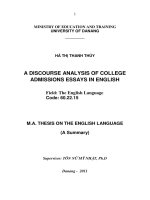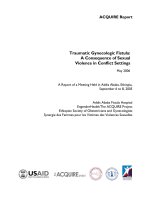evolution of media violence essay
Bạn đang xem bản rút gọn của tài liệu. Xem và tải ngay bản đầy đủ của tài liệu tại đây (24.95 KB, 2 trang )
Evolution of Media Violence
The evolution of broadcast programming can be identified into
four stages. The
first stage covers the debut of commercial radio in the 1920's.
At that time
the tone was considered proper, and formal. For several years
radio
broadcasting emphasized classical or semi-classical music, and
historical drama.
Commercials were kept brief and always discreet In the second
stage of
programming, which was called The Golden Age of Radio, shows were
action
adventures. Vaudeville-Comedy was also popular. The hard ships
of the 1930's
and then World War II, made it important for citizens to be able
to relax as
radio brought popular entertainers and adventure stories into
their homes.
The third stage of programming lasted from 1945 until the early
1950's, when
television had a explosive growth. Television was preserved as
"radio with
pictures." Many entertainers and entire programs were
transferred successfully
from radio to television. At the beginning of the fourth stage,
known as The
Golden Age of Television, variety shows were the most popular
program format.
Another television staple of this era was the western. In the
late 1950's
action-adventure became popular.
Since the 1960's there has been a increase in violence in the
media (television).
In 1968 censorship laws were relaxed in favor of a rating system
that allowed
any type of subject matter to be filmed. This permitted
Hollywood to specialize
in films featuring excessive violence. Many individuals and
citizen groups have
expressed concern about the level of violence in television
programs,
particularly in action-adventure series and cartoons. They feel
that viewers,
especially children, may learn to see violence as the way to
resolve conflicts.
Television can influence peoples mental picture of the world.
This is
especially true for younger viewers who rely heavily on
television and other
media for their understanding of the world beyond their
neighborhoods.
Television today is failing to provide a complete, unbiased
picture of reality.
United Stated has a long standing tradition of freedom of speech,
and freedom of
press. These freedoms have hampered the government in attempting
to directly
limit censor the depiction of violence on television. In reason
times the
networks and producers have felt pressure from concern citizens
who are critical
of the violence displayed on television.









